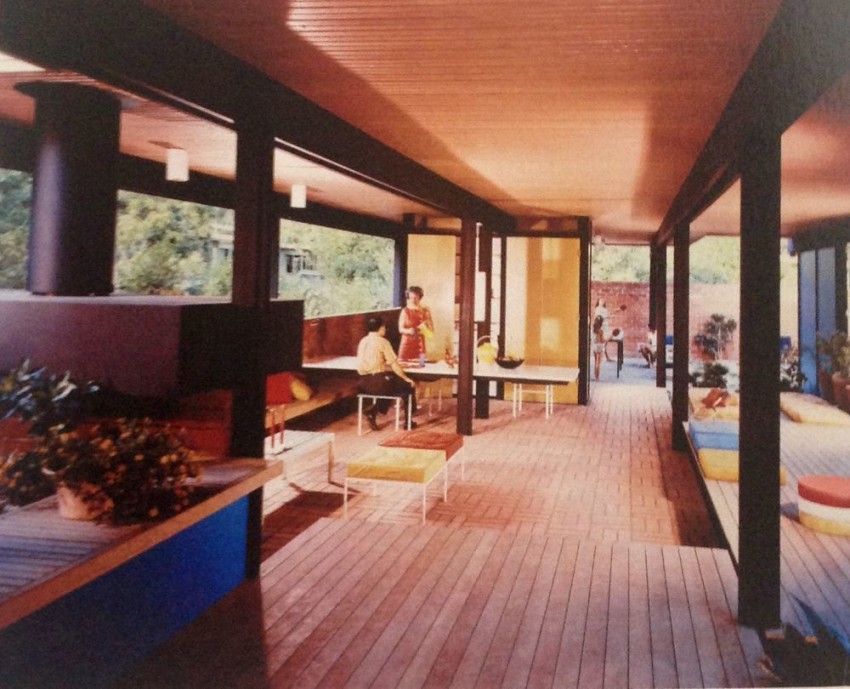In the popular BBC drama "Downton Abbey," it’s easy to fawn over the decadent, lavish, and seemingly ornate life of Europe in the early 20th century. The gold, the castles, the aristocrats, the maintenance and up keep of traditions, and the differentiation between a bouillon spoon and a soup spoon, seemed far and distant to the “New World”, an ocean away. It was because of the decadence, a string of new ideas was pursued; creating a reaction toward traditions and lavish lifestyles. The necessities of show were reinvented into clean lines, form and function, pre-fabrication, mass production, and money or lack there of.
The current exhibition at the National Art Center Tokyo is California Design, 1930-1965: “Living in a Modern Way”, showcasing the beginning of the west coast’s American Dream, divided into five sections: Introduction, Shaping, Making, Living, and Selling. California was much different than New York. New York with its history and culture was established. California, be it Northern or Southern was and is, casual, free of excess, holds fewer expectations and, with the exception of Hollywood, California was undiscovered.
There has always been such ease with Modernist designs, easy on the eye, ever so stylish, functional, never under nor overworked. As designers and architects began to move out of Europe, fearing the beginnings of the next war, settling into the ever blue skied white cloud cities of California seemed opportune. America was ever so optimistic: the future was anything one made it to be, anything was possible, one made the future with the present. With that, the journey began; illustrating the golden age of Californian Modernism using objects, photographs, drawings and film.
Breaking free from molds of the century past, forms, typographic layouts, and fashion initiated an examination of materiality. Surfaces, processes, progression of technology was evident in new methods and applications. Weaving about the posed objects, a dialogue is created between the five sections of the show: practically beautiful objects re-contextualising the original environment depicting emotion, narration and craft. These artifacts, period pieces reflective of their time, escape into fantasy while being utilitarian highly functional.
To say the exhibition is an in-depth look of the era would be an over statement. However, if you’re wanting a personal exchange with material methodology and processes, the ways of pushing boundaries, and an exploration of emerging era of designers where industries came together to build a cohesive community, this exhibition lays out a part of that history. If that isn’t of interest, seeing masterpieces made by master crafters allows for a true understanding of the relationship designers have with their medium, which doesn’t quite translate the same in any sort of documentation. Or alternatively visiting the Knoll shop in Aoyama would give you as much of an education of the designs of the past. Even the Herman Miller packing stays true to its original form.
Perhaps surrounded by names such as Neutra, Eames, Shulman, Schindler and Wester, I couldn’t help but wonder about the dialogue between today’s design with the optimistic era. Two wars, yet ideas were flooding, there was no box to be inside of, unless they’re case study homes: experimentation, mastering crafts, blurring the line between art and design was as prevalent as ever.
In the midst of, or as some believe, at the end of, a recession, I have, as a creative, such hopes of how the world would change. It was my belief that companies were yearning to be different, to stand out amongst crowds and wanting to challenge the status quo: redefining the way the mass public experienced with the world. However, standing before this exhibition I realized the optimistic era hadn't dawned on us, but rather it stayed put in the movement 80 years ago.
© Japan Today Take our user survey and make your voice heard.
Take our user survey and make your voice heard.















1 Comment
Login to comment
rrslaton
This is one of Japan Today's better reviews, as it places the process of the exhibition within its context, rather than presenting the too common type of review that lists items in an exhibition with a sentence of two description but without merging the pieces in what the curator was communicating.